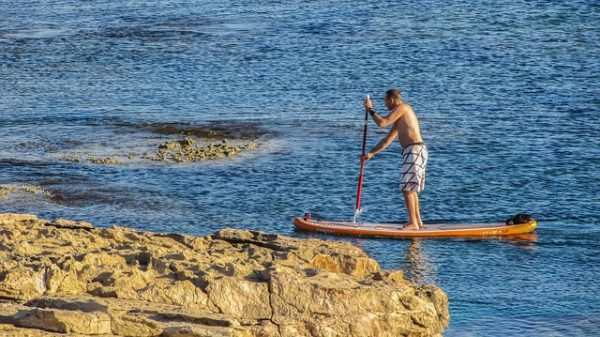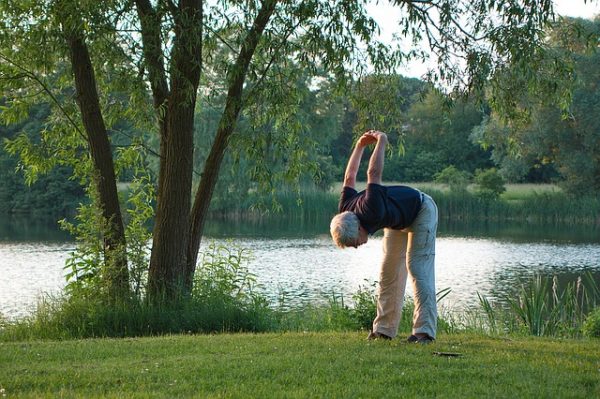A little mishap occurred in Dr. Michael Duffy’s neighborhood this morning. He had to tend to a boy who fell out of a tree. Minor bumps and bruises, but no broken bones, thank goodness. Dr. Duffy says he’d much rather see kids, including his own, playing outside, even climbing trees, than sitting inside playing computer games.
Dr. Duffy is Medical Director of Mercy Primary Care in Maine. One of the things he enjoys most is helping and encouraging patients of all ages to be more active, including kids.
“You want your kids to be active,” he told me. “As a physician, I encourage my patients and my own children to be physical. Climb trees, ride bikes. Is the risk of injury there? Sure, but with necessary precautions, it’s a reasonable one to take. I would prefer they were out there climbing a tree even with the risk of falling than to have them inside playing [on the computer.]”
Safety tips for kids
The right precautions include wearing a seatbelt, wearing a helmet when you’re bicycling, knowing the rules of the water, and wearing life preservers.
If you’d like a comprehensive list of safety tips, I found a great resource — Safe Kids Worldwide.
For instance, here are their top boating safety tips — just in time for summer.

Mojpe / Pixabay
Boating safety tips for babies up to a year old
- According to the U.S. Coast Guard’s Office of Boating Safety, babies should not travel on a boat, including rowboats, kayaks, motorboats, and sailboats until they are at the appropriate weight to wear an approved personal flotation device (PFD). How to choose the right PFD.
- Hold your baby throughout the entire boating experience while you are also wearing your own life jacket. Allowing a baby to rest in a car seat is not a good option since the car seat will sink if the boat capsizes.
- Infants and young kids are at a higher risk for hypothermia, so if you are taking babies on a boat, just take a few extra precautions to keep them warm. If your babies seem cold or are shivering, wrap them tightly in a dry blanket or towel.
Boating safety tips for kids from 1 to 4
- Always have your children wear a U.S. Coast Guard-approved personal flotation device (PFD) while on boats, around open bodies of water or participating in water sports. How to choose the right PFD.
- Remember that things such as water wings, noodles, and other swimming aids are fun toys for kids, but they should never be used in place of approved PFDs.
- Explain some basic boat rules and have everyone follow them. Children need to understand and follow rules such as keeping their hands and feet inside the boat at all times and not running on a boat.
- Every child is different, so enroll children in swimming lessons when you feel they are ready.
Boating safety tips for kids 5-9
- Same as above and
- Teach children that swimming in open water is not the same as swimming in a pool: They need to be aware of uneven surfaces, river currents, ocean undertow and changing weather. Adult supervision is a must.
Boating safety tips for preteens and teenagers
- Always have your children wear a life jacket approved by the U.S. Coast Guard while on boats or around open bodies of water or participating in water sports. Make sure the life jacket fits snugly.
- Teach children that swimming in open water is not the same as swimming in a pool: They need to be aware of uneven surfaces, river currents, ocean undertow and changing weather.
- Enroll older kids in a boating safety course. Better yet, enroll with them.
- Let your teen operate a boat only in a supervised setting and in adherence to laws in your area. Laws regarding the operation of a boat or watercraft vary from community to community.
Weekend warrior?
Being physically active should be a lifetime pursuit says Dr. Duffy. But with age, you might find that you can’t do all the things you used to do. You might think you can, but reality may come back to bite you.
He’s in his late 40s, so he knows what he’s talking about! “We still try to play as much as we can but our bodies aren’t as good at bouncing back as they used to be,” he said.
So you have to be sensible and take the same precautions we mentioned for young kids: Wear a seatbelt, wear a helmet when you’re bicycling, wear life preservers and know the rules of the water when you’re doing things like boating and paddle boarding.

dimitrisvetsikas1969 / Pixabay
Paddle boarding? Dr. Duffy and his wife just bought two paddle boards and he thinks they’re a lot of fun and they can give you quite a workout.
“If you paddle around quite a bit, you’ll be sore in odd places the next day,” he said. “That’s because it’s a lot about core strength. Your core muscles are firing to maintain good balance. Every little muscle, your feet, your toes, are trying to keep you upright while you’re paddling in motion. Then there’s little waves and the wind —things that you’re constantly correcting for. It really is a full body workout.”
A bit of advice from a physical therapist
Beware of the weekend warrior syndrome was the advice Mike Moras gave me for another Catching Health blog post: Decade by decade. How to keep your body strong and agile. Mike’s a physical therapist at Back in Motion Physical Therapy.
“You’ve got folks like me, who work and have kids,” he said. “You can’t fit in exercise during the week, so you squeeze it in on Saturday and Sunday. You may also be starting to have some arthritic changes and can’t recover as quickly as you did in your 30s. That 5K you ran on Saturday is now taking more than 24 hours to recover from and you’re feeling it. Your legs are stiff and sore for a couple days.”
How to be active in your 40s
- Get out and jog or go for a walk.
- Do some kayaking or go for a weekend hike.
- Look for physical activities you can do with your family.
- Don’t try to break your personal record on your 5K or 10K or go for a 50-mile bike ride on the weekend. If you do, you might be reeling in pain the next few days.
- Continue to include a cardio workout and some weight training.

cnort / Pixabay
How to be active well past your 40s
Dr. Duffy said he sees more and more older people who are physically active and reaping the rewards. “These days, we’re seeing a healthy emphasis on physical activity and healthy lifestyles rather than reliance on medication, which is terrific,” he said. “As a physician, there’s nothing more rewarding to me than discontinuing a patient’s chronic medication because their lifestyle has improved,”
What if you’ve been sedentary for longer than you care to admit, but would like to do something only you’re afraid you’ll hurt yourself?
“Fear of injury can be a significant barrier to adopting a really healthy lifestyle,” said Dr. Duffy. “I work with patients who have been sedentary for so long they just don’t trust that their bodies are going to be able to tolerate even basic physical activity. I recommend they start small. Start walking, then walk quickly, briskly. Then get into some core strengthening physical activities.”
Start small and work toward activities you’d really like to be able to do. Ask yourself some questions, said Dr. Duffy. “What would you see yourself doing that you might feel is impractical right now? What would it take to get to that goal? Maybe you’ve always wanted to go canoeing or bicycling. It’s feasible for you to get there no matter what your age of condition. Working with a trainer is a great way to gain confidence in your body’s capabilities and then start taking steps toward the activities that you would most like to do. Group activities can be really helpful, too.”
Before you begin any new physical activity, it’s always a good idea to check with your health care provider first, so you can assess any potential risks. But the bottom line is: Be active. Don’t use your age as an excuse to do nothing.
One more thing to remember
Good nutrition is also important says Dr. Duffy, especially with age. “When we’re in our 20s,” he said, “we can get away with eating most anything. Physical activity can burn off those bad calories. It becomes very unlikely through your 40s, 50s and beyond that you’re going to achieve the level of intensity needed to manage or lose weight. I encourage people, particularly the elderly, to focus hard on nutrition. What are you putting in your body? What are you eating and drinking throughout the day to make sure that you’re choosing good calories? That will then allow you to go there and achieve your physical goals?
When I asked Dr. Duffy who he considers elderly, he was quick to say that the lines have blurred so much it’s become a vague category.
“I have people who are so physically fit at 80 that they are far healthier and more able to endure the physical activities they’d like to do than some of my patients in their 40s, no question,” he said. “We see people living longer, healthier lives these days more than ever and it all comes from making smart choices throughout their lives.”
How about you? What smart choices are you making about being more physically active? What are some of your successes and challenges?



Leave A Comment